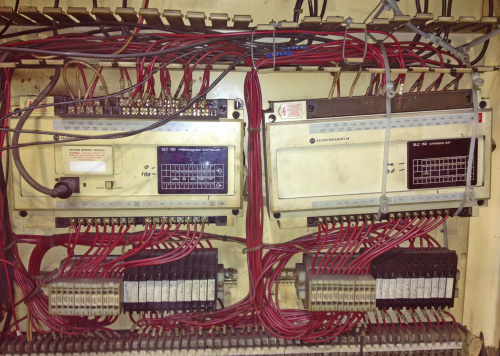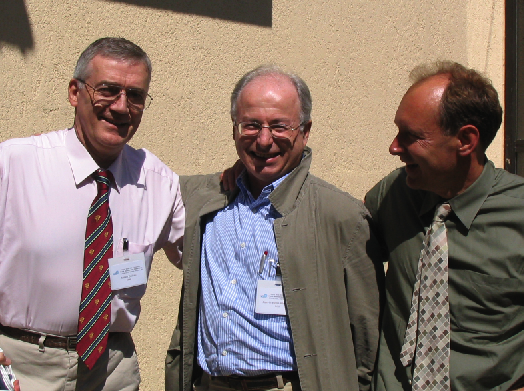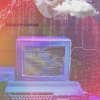Do you remember when cellular phones became "smartphones"?
It seems like it basically happened overnight, around the time that words like "Sidekick" and "BlackBerry" were losing their appeal. About the time that Microsoft abandoned the loathsome and WinCE-based "Windows Mobile" in favor of the superior "Windows Phone" OS. Just on the verge of Apple turning their iPod Touch into a worldwide mobile telephony juggernaut (had they been just a few months ahead of the phrase "smartphone," they may have genericized the word iPhone the same way they did iPod).
But why did we choose the phrase "smartphone" when there were so many other words waiting in the wings: Superphone, PDA, Palmtop, BlackBerry (as a generic trademark)? Because before phones were "smart," the "smart technology" movement had already been rolling for years. Smart technology is the phrase that we've grown used to for describing ubiquitous computing, the idea that any electrical device could be imbued with electronic "smarts" to make our lives easier. In fact, before the smartphone, there was the smarthome:
(Photo courtesy of homecontrols.com)
The systems behind so-called smart homes probably represent the first serious push of smart technology into the commercial market. Home automation stallwart X10 was developed in 1975, just a few years into the rise of the consumer grade IC, and it's still in use today. That being said, for most of us home automation has come piecemeal through a variety of smart appliances, and not as a monolithic solution the way that BSR (later X10 Inc) would have liked it to. The fact is that even today, home automation is still trying to gain a foothold in the market, but it may finally have found one. Until recently, hardware was too large and bandwidth was too precious to enable the kind of ubiquity that X10 and its competitors were hoping for. But in the age of the iPhone and 4G wireless, their ship may have finally come in. Enter: The Internet of Things.
This is apparently what the Internet of Things looks like... (Image courtesy of talk2thefuture.com)
The Internet of Things is an attempt to bring home automation, ubiquitous computing and mobile technology together under one big umbrella. Unfortunately, any umbrella large enough to cover these technologies is so large that it can be hard to define the edges. After all, what would an internet of "not things" look like? In my line of work, I come across a lot of different people with their own definitions of IoT. Most people define it either too broadly, including things from military field-comms to servers and switches, or too narrowly, neglecting anything that isn't a consumer good or appliance. My working definition for what constitutes an IoT device is pretty simple and I think it covers all bases:
An IoT Device is any internet-connected, non-browser device that isn't a piece of network infrastructure.
Whenever we use the words Internet of Things, I think we really mean it in contrast to the Internet of Browsers, the chunk of internet devoted to searching, indexing and serving human-readable content. This is, after all, what most of us call the internet. That other layer where machines talk to each other without cat pictures or targeted advertising is the heart of the internet of things. This layer of the internet has existed for a long time, there have just been very few things on it.
We used to refer to non-browser devices as using M2M, or Machine-to-Machine, technology. M2M wasn't so much a part of the consumer sphere like smart homes were. M2M grew up from industrial automation and most of the M's that made it up were things like HVAC units, boilers, generators, powerplants, sprinklers and manufacturing equipment. They started as locally-networked devices, connecting controllers to actuators in large plants, but eventually grew onto the internet to accommodate sprawling industrial campuses. Devices that still identify as M2M today followed an entirely different evolutionary path than did IoT devices, and often still very much resemble the early PLCs from which they were developed.
The Original IoT (Photo courtesy of faithtechnologies.com)
Seeing as the ideas and technologies behind IoT have already been in development for about half a century, is IoT really a hot new paradigm-shifting technology? Or is it just a coat of fresh paint on an old scam? A tool for marketing pinheads (like me) to sell you expensive and complicated appliances? Well... there's no doubt that there are piles of Silicon Valley startups, each tripping over the other to develop IoT's "killer app." And it's also very likely that retailers of technological tchotchkes and e-kitsch (like that one place you only shop at 40,000 feet) will use it as a badge to sell chintzy wares. I also think that the phrase represents a convergence of technologies that was going to happen eventually anyway, and would need a name. It's likely that we're in the IBM Simon stage of the Internet of Things. We have a feeling that there's potential, we're trying to build objects around it but we just haven't felt our way to the "smartphone" yet. After all, it took the "smart devices" movement more than 30 years to give us a real smartphone. Heck, it took the all-out venture capitalist bloodbath of the Web Bubble to form companies like Google and ultimately, social media.
The type of innovation that we're used to today is the result of a lot of brilliant people working for a lot of ambitious (if somewhat reckless) people, throwing things at the wall and seeing what sticks. It's easy to become cynical in this environment, where every solution is a sales pitch and the heavy hitters are expensive thermostats and TVs that can spy on you. But as the people who are likely building the Internet of Things, we owe it to ourselves not to get fed up with the hype and tune out. The standards and protocols that are being developed right now are likely to become the backbone of a new kind of human-machine interaction. We could soon find that most of our interaction with the web is taking place without a screen or a keyboard. Massive amounts of personal data and metadata will be generated and transported using these standards and protocols. It is so, so important that we take the same care and attention in developing our Internet of Things solutions as did the architects of the Internet and the World Wide Web.
Robert Cailliau, Jean-François Abramatic and Tim Berners-Lee. Architects of the World Wide Web (photo courtesy of Wikipedia Commons).
This attention and care will be rewarded with a secure and connected future. A future with fewer screens and more smart objects. A future with the potential to be distributed, with any luck, a little more evenly. So let us choose to be skeptical, rather than cynical, about the promises of IoT. Let us choose to get excited about everything that it can be instead of rejecting it for what it is. It's our turn to contribute to the Internet; let's do better than pop-up ads.













Internet of Things, like home automation, will not take off until the following is done:
1) A free & open standard for the protocol between the devices and controller. Must be hobbyist & open source friendly for both the controller and things.
2) IPv6 & local controller. No, my thing is not punching a hole in my firewall to a website. My thing must be fully functional independent of an Internet connection and support from the seller/manufacturer.
3) Easy, fast, plug & play provisioning.
4) Must use a mesh network that can allow a device to last a year on battery power (see https://pinocc.io/ )
I believe the first internet thing was the net connected coke machine: https://cseweb.ucsd.edu/~bsy/coke.history.txt
For the most part, smart-home has come to mean - a remote controlled bulb, fan, appliance, toaster, fridge, thermostat, etc. - some internet connect gadget that provides data (pictures, weather, news)
I question if these things really make the home "smart." It doesn't take a rocket scientist to realize the maintenance headache that the smart-home entails for the minuscule added benefit. And some of the offerings make me cringe. Ok, so I can take out my phone, open up an app, connect to my bluetooth light and adjust it. No thanks.
Here is what real progress would be:
a 10 fold decrease in the cost to remodel your house
why do we still have neanderthal ways of painting a wall? I still have to use masking tape and rollers and painstakingly apply paint. Why can't this process be as easy as applying digital paint on a screen?
ways to harness the heat in the summer and the cold in the winter to modulate the other.
None of the projects (which presumably includes the people behind them) building things which fall under the subject seem to be concerned whatsoever with defining the term "IoT". And for good reason.
It doesn't matter what you call it.
The availability of inexpensive networking modules (down 300% in just two years), powerful SoC (system on chip) development boards, and a growing community of makers are all indicators of a changing tide that's as strong as the advent of personal computing in the 80's.
It's still early days yet, and if you're old enough to remember, it might seem familiar that the internet age was also preceded by hyped buzzwords like "information superhighway", "cyber{everything}", "internet online". The big companies eventually caught wind and tried hard to stake their claim. Some managed to do so, for a time. But in the end, what remains?
Not the buzzwords, not the hype, and not the corporate ownership. You don't see "http://" on a single billboard anymore, and you don't ask your friends if they own a PC, are "online" or have an "email account".
Call it whatever you want. You're free to spend all your time condemning the definition of a phase that will be forgotten in less than a decade. But you'll have entirely missed the point.
Oh, and it's a hell of a lot easier to tell someone you're doing, "IoT stuff" than, "building end-to-end securely auto-provisioned fault-tolerant mesh networks comprised of protocol agnostic interconnected nodes with heterogeneous embedded hardware".
I just want to laugh for a moment about how we are using the term "smart" phone in an age when things adapt and change very quickly. We will soon look at "smart" phones as being out of date or old tech. Let us move beyond smart items and continue to develop our smarts.
IMHO IoT is an awkward term. It's like calling a smartphone a "Mobile Data & Voice Terminal - MDVT"
On the other hand "Smart" as in Smart City, Smart Home, Smart Grid, Smart Car, etc is overused. Have to point out that it is "smartphone" and not "smart phone" - amazing what a difference a space character can make.
WoT (Web of Things) is another term that is being used, but not as widely. I think that WoT reflects more of the M2M view. But of course, that doesn't help with marketing.
Not a bad article but is missing a few recent pieces of the jigsaw - namely the arrival of affordable and low power IoT capable devices such as the ESP8266 and ESP32. With these we can package small, low power devices, with a bunch of sense-and-control technologies, and deliver useful devices for a low price. Due to reduced size, we can now integrate these devices into existing homes without additional wiring or holes-in-walls. These days everything I design is intended to be installed by anyone who can use a screw-driver and find their fuse-box.
The protocols which allow plug-and-play (from multiple manufacturers) are not yet complete, however they are progressing rapidly. So too the situation for security. All of my systems use the equivalent of AES along with automated key management (with continuous key generation). Good luck trying to hack any aspect of my home!
As an example, I recently designed a solid-state light switch assembly which integrates a thermally isolated temperature and humidity sensor, a smart, multi-sensor PIR device, control for in-room devices (such as HVAC zone control), an OLED touch screen, voice command, with an optional upgrade for AV intercom. The base unit should retail for around $40 and the entire device is designed to fit in place of any existing 2-pole 2-way switch.
Of course the IoT devices communicate to a server which also acts as a gateway to the internet. In my case this is a 7 inch touch screen which takes the place of your average HVAC control point. This allows remote monitoring, control and communications. However the architecture is able to fail-over to a second gateway or even a router-connected laptop or PC when loaded with the equivalent app. Ultimately the system is able to run independent of the internet albeit with degraded services (I use Alexa etc for voice processing).
I do not agree with all IoT enabled devices and there are glaring holes. For instance my washing machine will wifi-me when the water filter needs changing. This is a completely useless function because I see the corresponding glaring, flashing message whenever I open the fridge door. I also don't need a camera in my fridge and I especially don't need to be told I've run out of milk. Annoyingly, however, when I went to replace my salt water softener recently, I couldn't find a single one that could IoT me to say the salt was running out or that the system had sprung a leak! Also, with Utilities across America moving to punish home owners who install private solar, any IoT system worth having must integrate some form of load controller to optimize energy use and avoid crippling surcharges (which apply in States such as Arizona).
I would also like to see appliance manufacturers step up. For instance, my Bosch dishwasher uses two motors, an impeller, two filter screens, a heater, particle detector, a few valves, relays, control board and a bunch of piping. How nice it would be (and how simple to implement) if it could report precisely the cause of any malfunction. I estimated, on my $1800 Bosch, the cost of providing precision fault diagnosis would add around $30 to the build cost of the machine (BOM). This would avoid a double call-out, shorten diagnostic time, and allow the service repair man to arrive with the correct parts, ready to install.
Iot is in other words... realy is about "Things" , with means for a commom person: - anything that is not a "computer / computer like" , conected to another thing , that is not a "computer / computer like". - or M2M , in with Machine is the end device, like a Lamp and a Air Conditioner ...
thats basicaly IOT ... S "smartTv" is just a TV, until it can conect to something in my house, and do something without i notice or care...
Or a machine in the industrial area broke, and it reduce the scale and speed in the previews line in order to not overflow production ....
Bravo Nick !
The Internet of Things has many years being a hot topic, but what exactly is it i think this explains a lot: Internet of things article from beyondtech
My favorite phrase currently is: "Internet of Things you don't need." Having said that, my house is connected, when I arrive after sunset, lights come on automatically at bed time they go off automatically. I've got motion sensing radars and all manner of monitoring systems in the works.